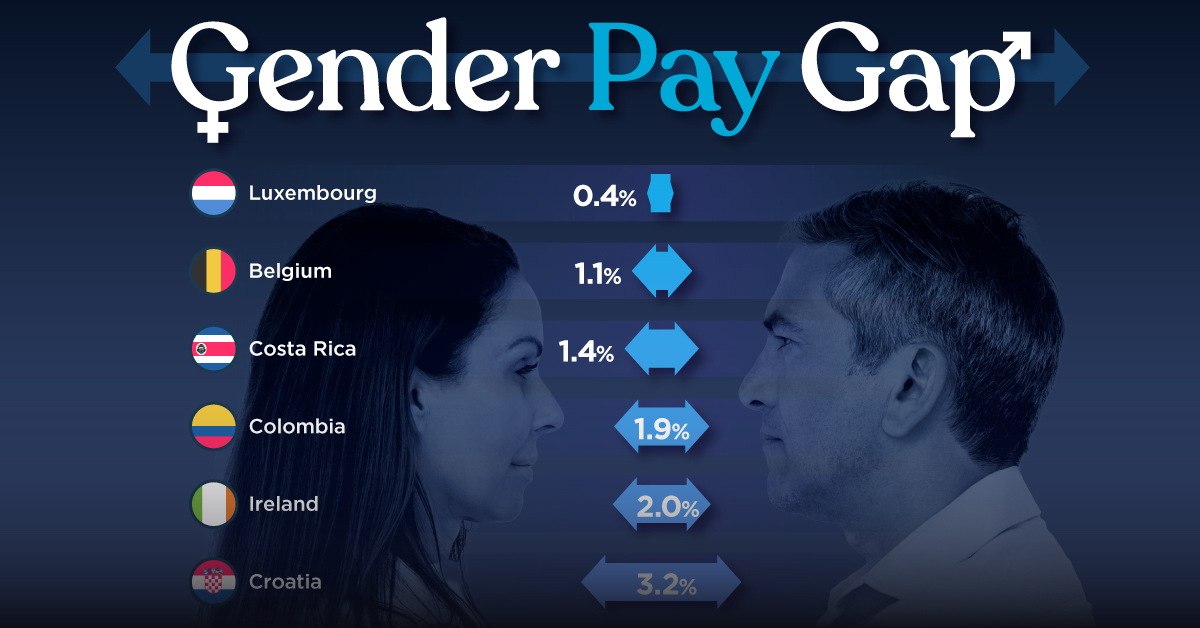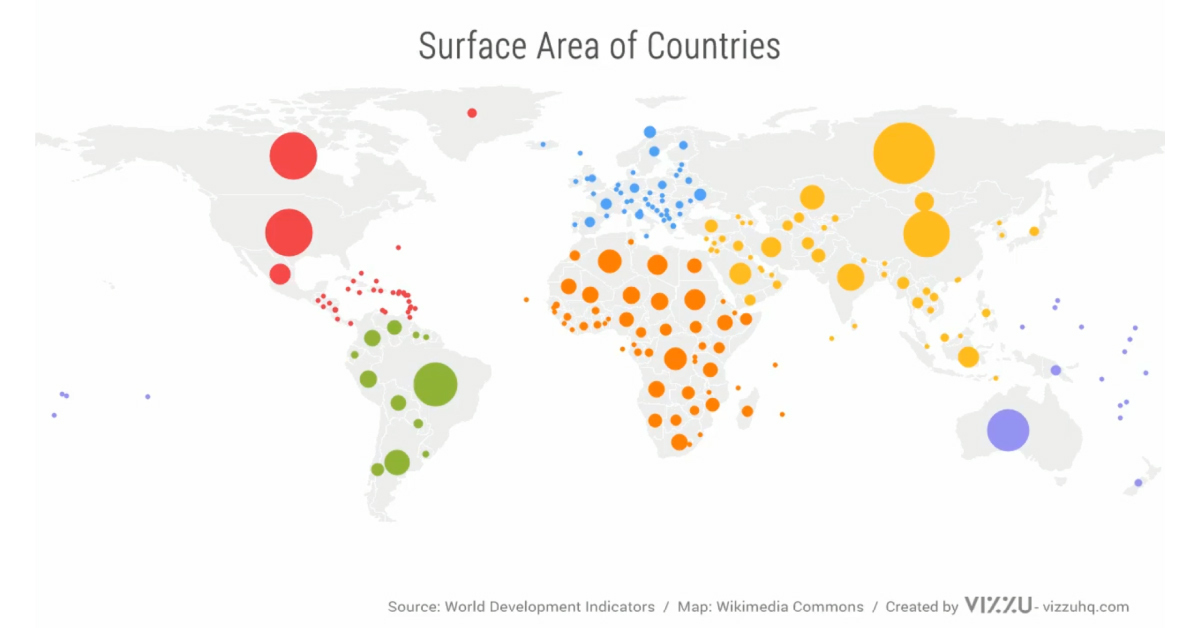Demographics
Animated Map: The Comparative Might of Continents
Animated Map: The Comparative Might of Continents
We’ve come quite a long way since the time of Pangea. Today, the world’s continents are home to over 7.8 billion people, and each one is unique in its own way.
This video from the data visualization tool Vizzu compares the surface area, population, and GDP of the continents—all in terms of their contribution to the world’s total. Let’s dive further into the results of each category.
Click through to source to see the country breakdowns. Antarctica has been excluded from these calculations.
Surface Area: Does Size Matter?
When it comes to sheer land mass, Asia emerges on top with over one-third of the global surface area. On that front, it certainly has a little help from the combined forces of Russia and China, even as the former overlaps Eastern Europe as well.
| Rank | Region | Share of Global Surface Area | Largest Country |
|---|---|---|---|
| #1 | Asia | 36.5% | 🇷🇺 Russia |
| #2 | Africa | 22.3% | 🇩🇿 Algeria |
| #3 | North America | 17.1% | 🇨🇦 Canada |
| #4 | South America | 13.2% | 🇧🇷 Brazil |
| #5 | Oceania | 6.4% | 🇦🇺 Australia |
| #6 | Europe | 4.6% | 🇷🇺 Russia |
Africa comes in second, but doesn’t lag behind by much. A stone’s throw from Europe, Algeria is the largest country on the continent—and the 10th largest in the world.
Failing to grasp the true size of Africa is a common mental mistake, as many maps systematically underestimate its scale. The continent could easily fit the entirety of China, India, the U.S., and multiple European countries within its borders.
Population: Packing People Together
Another way to look at things is in terms of the number of inhabitants in each region. Asia is once again on top, with almost two-thirds of the world squeezed onto the continent.
| Rank | Region | Share of Global Population | Most Populous Country |
|---|---|---|---|
| #1 | Asia | 61.8% | 🇨🇳 China |
| #2 | Africa | 16.1% | 🇳🇬 Nigeria |
| #3 | Europe | 8.2% | 🇷🇺 Russia |
| #4 | North America | 7.7% | 🇺🇸 U.S. |
| #5 | South America | 5.6% | 🇧🇷 Brazil |
| #6 | Oceania | 0.5% | 🇦🇺 Australia |
Asia’s lead in population is impressive, but it’s a margin that is unlikely to last forever.
By the year 2100—new estimates show the populations India and China could start to dip. Meanwhile Nigeria, which is already Africa’s most populous country with near 196 million people, could potentially quadruple in numbers in the same time frame.
In this metric, Europe also rises to third place. This is thanks again to the approximately 146 million people within Russia. However, if only the countries located completely within the continent are considered, Germany’s population of nearly 84 million would win out.
GDP: Emerging Wealth Overtakes
Finally, economic output—measured in terms of Gross Domestic Product (GDP)—is the most common way to assess the relative prosperity of countries and continents.
At this, the U.S. dominates with $21.4T according to the World Bank, though it swaps places with China which boasts $23.5T when adjusted for purchasing power parity (PPP).
| Rank | Region | Share of Global GDP | Richest Country (both nominal and PPP) |
|---|---|---|---|
| #1 | Asia | 36.9% | 🇨🇳 China |
| #2 | North America | 28.9% | 🇺🇸 U.S. |
| #3 | Europe | 23.9% | 🇩🇪 Germany |
| #4 | South America | 5.1% | 🇧🇷 Brazil |
| #5 | Africa | 3.1% | 🇳🇬 Nigeria |
| #6 | Oceania | 2.1% | 🇦🇺 Australia |
Source: World Bank for both GDP Nominal and PPP, 2019.
Global wealth share drops sharply between Europe and South America, though it’s worth noting that rising inequality is also hidden under the surface within many high-income regions.
In terms of overall GDP, the Asian continent makes up the lion’s share. Asia is also home to many of the world’s emerging markets—which means there may be an even more pronounced shift of wealth towards the East in coming decades.
Demographics
The Smallest Gender Wage Gaps in OECD Countries
Which OECD countries have the smallest gender wage gaps? We look at the 10 countries with gaps lower than the average.

The Smallest Gender Pay Gaps in OECD Countries
This was originally posted on our Voronoi app. Download the app for free on iOS or Android and discover incredible data-driven charts from a variety of trusted sources.
Among the 38 member countries in the Organization for Economic Cooperation and Development (OECD), several have made significant strides in addressing income inequality between men and women.
In this graphic we’ve ranked the OECD countries with the 10 smallest gender pay gaps, using the latest data from the OECD for 2022.
The gender pay gap is calculated as the difference between median full-time earnings for men and women divided by the median full-time earnings of men.
Which Countries Have the Smallest Gender Pay Gaps?
Luxembourg’s gender pay gap is the lowest among OECD members at only 0.4%—well below the OECD average of 11.6%.
| Rank | Country | Percentage Difference in Men's & Women's Full-time Earnings |
|---|---|---|
| 1 | 🇱🇺 Luxembourg | 0.4% |
| 2 | 🇧🇪 Belgium | 1.1% |
| 3 | 🇨🇷 Costa Rica | 1.4% |
| 4 | 🇨🇴 Colombia | 1.9% |
| 5 | 🇮🇪 Ireland | 2.0% |
| 6 | 🇭🇷 Croatia | 3.2% |
| 7 | 🇮🇹 Italy | 3.3% |
| 8 | 🇳🇴 Norway | 4.5% |
| 9 | 🇩🇰 Denmark | 5.8% |
| 10 | 🇵🇹 Portugal | 6.1% |
| OECD Average | 11.6% |
Notably, eight of the top 10 countries with the smallest gender pay gaps are located in Europe, as labor equality laws designed to target gender differences have begun to pay off.
The two other countries that made the list were Costa Rica (1.4%) and Colombia (1.9%), which came in third and fourth place, respectively.
How Did Luxembourg (Nearly) Eliminate its Gender Wage Gap?
Luxembourg’s virtually-non-existent gender wage gap in 2020 can be traced back to its diligent efforts to prioritize equal pay. Since 2016, firms that have not complied with the Labor Code’s equal pay laws have been subjected to penalizing fines ranging from €251 to €25,000.
Higher female education rates also contribute to the diminishing pay gap, with Luxembourg tied for first in the educational attainment rankings of the World Economic Forum’s Global Gender Gap Index Report for 2023.
See More Graphics about Demographics and Money
While these 10 countries are well below the OECD’s average gender pay gap of 11.6%, many OECD member countries including the U.S. are significantly above the average. To see the full list of the top 10 OECD countries with the largest gender pay gaps, check out this visualization.
-

 Mining2 weeks ago
Mining2 weeks agoCharted: The Value Gap Between the Gold Price and Gold Miners
-

 Real Estate1 week ago
Real Estate1 week agoRanked: The Most Valuable Housing Markets in America
-

 Business1 week ago
Business1 week agoCharted: Big Four Market Share by S&P 500 Audits
-

 AI1 week ago
AI1 week agoThe Stock Performance of U.S. Chipmakers So Far in 2024
-

 Misc1 week ago
Misc1 week agoAlmost Every EV Stock is Down After Q1 2024
-

 Money2 weeks ago
Money2 weeks agoWhere Does One U.S. Tax Dollar Go?
-

 Green2 weeks ago
Green2 weeks agoRanked: Top Countries by Total Forest Loss Since 2001
-

 Real Estate2 weeks ago
Real Estate2 weeks agoVisualizing America’s Shortage of Affordable Homes













